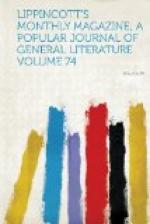The distinctness of consciousness from memory is also shown by dreams. Events which have passed are often recalled during the unconsciousness of sleep. The curious although common carrying of the memory of a dream over from the unconsciousness of sleep to the consciousness of waking movements further illustrates the complete distinction between the two cerebral functions.
If memory, then, be not part of consciousness, what is its nature? There is a law governing nervous actions both in health and disease which is known as that of habitual action. The curious reflex movements made by the frog when acid is put upon its foot, as detailed in my last paper, were explained by this law. The spinal cord, after having frequently performed a certain act under the stimulus of conscious sensation, becomes so accustomed to perform that act that it does it when the oft-felt peripheral impulse comes again to it, although the cerebral functions and consciousness are suspended. A nerve-centre, even of the lowest kind, once moulded by repeated acts, retains their impression—i.e. remembers them. Learning to walk is, as was shown in the last paper, training the memory of the lower nerve-centres at the base of the brain until at last they direct the movements of walking without aid from consciousness. The musician studies a piece of music. At first the notes are struck in obedience to a conscious act of the will founded upon a conscious recognition of the printed type. By and by the piece is so well known that it is played even when the attention is directed to some other subject; that is, the act of playing has been repeated until the lower nerve-centres, which preside over the movements of the fingers during the playing, have been so impressed that when once the impulses are started they flow on uninterruptedly until the whole set has been gone through and the piece of music is finished. This is the result of memory of the lower nerve-centres. At first, the child reads only by a distinct conscious effort of memory, recalling painfully each word. After a time the words become so impressed upon the lower nerve-centres that we may read on when our attention is directed to some other thing. Thus, often we read aloud and are unconscious of what we have read, precisely as the compositor habitually sets up pages of manuscript without the faintest idea of what




